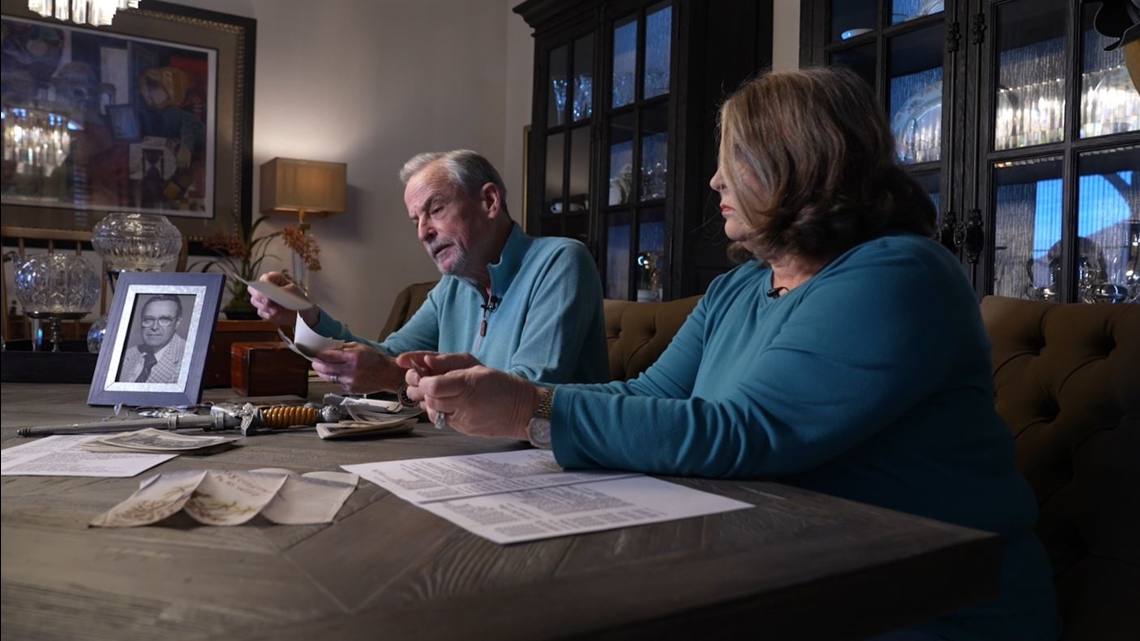“They didn’t talk about it and so we didn’t ask,” Gary Greenwood said of his father’s WWII memories and photos. “I sure wish I had now.”
COLLIN COUNTY, Texas — Gary Greenwood first saw the WWII photos when he was a teenager.
They were disturbing enough then. But now, as he clings to the memory of his late father who took those photos, he believes someone else should keep them as a reminder of some of humanity’s darkest days.
“He would only tell the funny stories,” Gary Greenwood said of his father Roger Greenwood, and the memories he would sometimes share of being a soldier in the Army during WWII.
“But I think that was common to many, many veterans. They just didn’t want to talk about all the bad things they saw.”
But after he died in 1980 at the age of 61, Roger Greenwood left behind a few keepsakes of his time in Europe. The Greenwood family kept them hidden away in a closet. They included a leather German first aid kit, a clutch of various European paper bills, Nazi medals and ribbons, and a Nazi officer’s ceremonial dagger emblazoned with a swastika.
And along with a detailed typewritten account of every city, every move, his Army unit made from 1943 to 1945, the collection of artifacts included dozens of black and white photos.
Most were as if taken by an American tourist abroad: a young man and his companions mugging for the camera, sometimes with a cigarette or rifle in hand. But other photos were, and still are, disturbing.


“They didn’t talk about it and so we didn’t ask. I sure wish I had now,” Gary said.
“Oh yeah, it kind of blew me away,” Gary’s wife Pam said. “To actually see them, it just wrenches your heart.”
And they believe it had wrenched the heart of that young soldier too. They believe Roger Greenwood took each photo.
“This is hard to see, but they’re stacked kind of like cordwood,” Gary said.
Picture after picture shows the internment camp victims the American soldiers were too late to save.
“In this picture they’re all laid out along the street,” Gary said.
For television and this article, we’ve blurred the photos. Decades later, they are still shocking and painful to see.
“Disturbing. Very disturbing,” Gary said of the photos in his father’s collection. “Hard for me to imagine. Not only how somebody could treat someone that way but how it came to pass that Hitler had so much sway over people.”
“I often marvel at how Hitler or Stalin or Lenin ever got power and got a whole country to go along a lot of it by fear to try to exterminate a whole people,” Gary Greenwood said. “Every time I look at them it’s almost unbelievable that it happened that way.”
But because it did, Gary and his family don’t want to put these pictures back on a shelf. They want them to go to a museum, a place where they can be studied and saved.
“Somewhere they can be protected and seen,” he said. “So that people who go can have one more item that shows them it was real, it really did happen and to remember that it happened and we should never forget this. And I hope people won’t, but I fear that they will.”
“But if we don’t remember our history we are destined to repeat it,” Pam Greenwood said.
“We want to make sure people have the ability to see what happened,” Gary Greenwood added. “And put in the back of their mind that maybe not let things get that far again.”
For that very reason, the Holocaust and Human Rights Museum in Dallas is working with the Greenwood family to authenticate the photos and determine if they can be added to the museum archives.
For Gary Greenwood, another contribution from his soldier dad, who helped win that difficult war.
“I’m glad that he did,” take the pictures Gary Greenwood said. “And I’m sure it was difficult for him too. I don’t think any of those guys really wanted to talk about it. But I’m glad he took the pictures so we could see. So we could show people what happened.”
And they would like to believe that the soldier who helped win the war with a rifle can keep sending a powerful message with his camera too.